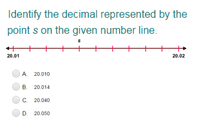Ordering Decimals (Thousandths)
To put decimal numbers in order, first write them in the place value table. If the decimal digits are not equal, then add zeros to the right of the last digit of the decimal number having fewer decimal digits.
Then, compare from left to right. First look at the whole parts.
If the whole parts are different, use them to order the decimal numbers.
If the whole parts are the same, start ordering the decimal numbers beginning with the tenth place and moving to the right until you find the digits that are different.
For example: Let’s order the decimal numbers 2.1, 3.231, and 2.51 from least to greatest.
Notice that the decimals do not have the same number of decimal digits.
Let’s write these decimal numbers in place value table and add extra zero (or zeros) to the end of the decimal number with less decimal digits.
| Ones | . | Tenths | Hundredths | Thousandths |
| 2 | . | 1 | 0 | 0 |
| 3 | . | 2 | 3 | 1 |
| 2 | . | 5 | 1 | 0 |
Now, notice that the whole parts of all the numbers are not equal.
As 2 < 3,
2.100 and 2.510 are smaller than 3.231.
Let’s now compare 2.100 and 2.510 by comparing their tenths digit.
As 1 < 5,
2.100 is smaller than 2.510.
So, the decimals can be ordered from least to greatest as:
2.100, 2.510, 3.231, or,
2.1, 2.51, 3.231
A B C D E F G H I J K L M N O P Q R S T U V W X Y Z
Help
The correct answer is
Remember :
The smallest number is the one that comes first while counting.
Solution :
To arrange the given numbers in order from smallest to greatest, find the smallest number among all the given numbers.
21,27,23
21 is the smallest number.



